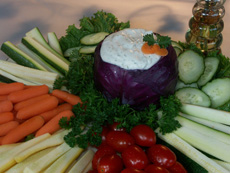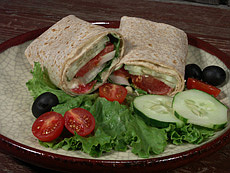|
Elevate your enthusiasm for eating well!
12
Tips for a Vibrant Total Vegetarian Diet
Vary Your Veggies —
Before we knew about vitamins, minerals and phytochemicals, it
was easy to get the proper amounts of these nutrients because
God color-coded our food! Choosing dark green insures calcium
and other nutrients, while red and orange veggies give us beta
carotene, lycopene and other antioxidants. Now we know the importance
of colorful vegetables; it turns out there are thousands of phytochemicals
that pour the benefits into our food!
And don't forget the onions and garlic! The allium family of vegetables
includes onions, garlic, leeks, scallions and chives, and may
be instrumental in addressing elevated blood pressure and high
cholesterol, as well as bacteria and yeast infections. What a
blessing that most savory dishes get their rudimentary flavor
base from onions and garlic. Steam up onions and garlic often
to serve with an otherwise plain burger and you'll get rave reviews!
 Discover Fiber-rich Fruit —
Choose whole fresh fruit instead of juice to get the full intended
benefit of nature's original fast food. As Dr. Zeno Charles-Marcel
says, "Choose fruit, the whole fruit, and nothing but the fruit!"
And eating edible skins will give you lots of fiber as well
as other nutrients. With this in mind, whenever possible, go organic.
Discover Fiber-rich Fruit —
Choose whole fresh fruit instead of juice to get the full intended
benefit of nature's original fast food. As Dr. Zeno Charles-Marcel
says, "Choose fruit, the whole fruit, and nothing but the fruit!"
And eating edible skins will give you lots of fiber as well
as other nutrients. With this in mind, whenever possible, go organic.
To remove pesticide residues, make a fruit and vegetable wash
by mixing in a sink or basin:
- 2 tablespoons lemon juice
- 1 tablespoon salt
- 2 gallons water
Allow the produce to soak for about a minute, then scrub slightly
and rinse well.
For optimum digestion, eat fruits at one meal and vegetables at
another. Keep in mind that anything that contains seeds is a fruit,
botanically speaking. The means that tomatoes, cucumbers and squashes
are actually fruits and combine successfully with other fruits
for most people.
Go With the Grains —
Whole grains, of course. And be adventuresome! Try some quinoa,
amaranth and millet along with barley, kamut and spelt berries.
All of these are simple to prepare in a crockpot and are simply
delicious! Brown rice, whole wheat and oats, as well as stoneground
cornmeal are always good choices, as they provide essential vitamins
and minerals which have been stripped from refined flours and
most commercial products.
Watch Sodium Intake — And what should you be looking
for? Though no RDA for sodium has
been established, a salt-restricted diet would allow 400 mg of
sodium, and a moderate use of salt would be about a teaspoon a
day, or 2400 mg. Remember that many foods naturally contain sodium
without adding any salt. If you are serving a recipe that's fairly
high in sodium, be sure to balance it with side dishes that are
lower in sodium. Try granulated dulse on vegetables and nutritional
yeast flakes with a small amount of olive oil on popcorn, both
delicious ways to minimize the need for salt.
 Make Legumes a Mainstay —
Legumes comprise the large food category in which there are thousands
of varieties of dried beans, peas, peanuts and lentils. Most cultures
feature a grain and legume combination that is a mainstay of the
populous' diet. South America's beans, rice and tortillas, Asia's
rice and tofu, India's lentils and chapattis, the Middle East's
hummus and pita bread, all parallel America's favorite: the peanut
butter and jelly sandwich!
Make Legumes a Mainstay —
Legumes comprise the large food category in which there are thousands
of varieties of dried beans, peas, peanuts and lentils. Most cultures
feature a grain and legume combination that is a mainstay of the
populous' diet. South America's beans, rice and tortillas, Asia's
rice and tofu, India's lentils and chapattis, the Middle East's
hummus and pita bread, all parallel America's favorite: the peanut
butter and jelly sandwich!
Richer in protein than any other plant food, legumes are low in
fat, contain B vitamins, and lots of minerals. The fiber in beans
helps to stabilize blood sugar and should be included in each
day's menu. Canned beans are convenient to use, but fresh cooked
beans have better flavor and a firmer texture. Crockpot cookery
again provides a convenient way to prepare this staple from scratch.
See The Total Vegetarian Cookbook for recipes.
If you seem to have trouble digesting beans, pouring off and changing
the water during soaking, or every 20 minutes while cooking helps
to get rid of this problem.
Tofu, SoyCurls, and beans, peas and lentils of every color of
the rainbow fall into this nutrient-rich category of legumes.
So, be sure to incorporate some into your diet everyday!
Get a Little Nutty —
A handful a day of nuts and seeds provide satiety, the right kind
of fat, and an essential nutritional boost. Studies show that
nuts are helpful in safeguarding the heart. Raw nuts are best,
and all nuts and seeds should be stored in the refrigerator or
freezer.
Max the Flax —
Two tablespoons a day of ground flaxseed will help prevent constipation
and provide 4 grams of omega-3 essential fatty acid. Omega-3 has
been found to be beneficial in the prevention and treatment of
depression, to assist with normalizing the triglycerides, and
it gives the immune system a boost. If flax oil is taken, only
1½ to 2 teaspoons is needed to provide about the same amount of
omega-3. Many who use 1 tablespoon of flax oil each day report
a significant decrease in the inflammation due to arthritis.
Check Your Oil —
Fat is an essential part of our diet, but health depends upon
using the right kind of fat. When it comes to oil, remember that
all oils are 100% fat. Be sure to choose expeller-pressed or cold-pressed,
and keep in mind that canola and olive oil are the richest in
monounsaturates, which is desirable. Grape seed oil is high in
antioxidants, and flax oil is the highest in omega-3 essential
fatty acid as discussed above. If you're trying to lose weight,
consume fats in the packages God placed them in — nuts, seeds,
olives and avocadoes — and you'll do better. In every case, avoid
hydrogenated oils as they contain harmful transfatty acids.
Get Calcium —
Available from many sources, it's important to be sure you're
getting enough calcium. Dark leafy greens like kale, collards
and turnip greens provide the best source, but almonds, sesame
seeds, figs and carob powder are rich in calcium as well. Arugula
is a spicy herb that is higher in calcium than any other cultivated
green, and is delicious in salads. To get the recommended 1,000
– 1,500 mg for post-menopausal women, you may need to include
a supplement. Remember that calcium citrate is the most easily
absorbed form found to date, and magnesium, boron and vitamin
D are needed for proper assimilation. Take a daily 30-minute walk
in the sunshine to get your vitamin D!
 Shun the Sugar —
Keep your intake of even healthy sweets to a minimum, serving
desserts only a couple days per week. Whenever possible, use whole-food
sweeteners like dates, or other fresh or dried fruits. Check out
the Carob Pudding and the Banana Date Cookies. They're plenty
sweet but with no refined sugar. Sweet!
Shun the Sugar —
Keep your intake of even healthy sweets to a minimum, serving
desserts only a couple days per week. Whenever possible, use whole-food
sweeteners like dates, or other fresh or dried fruits. Check out
the Carob Pudding and the Banana Date Cookies. They're plenty
sweet but with no refined sugar. Sweet!
The Berry Best to You! —
Strawberries, blueberries, blackberries: all kinds of berries
are chocked full of antioxidants, anthocyanins to be specific.
Scientists are learning that berries are contributing to the prevention
of everything from heart disease to cancer to age-related brain
decline, and they contain fiber, folate, and significant amounts
of vitamin C. So, have a berry merry time at breakfast, and include
them in desserts like Blackberry Cobbler!
A Time to Eat, A Time to Drink —
The right foods eaten at the right time provide optimum assimilation
of nutrients and the best safeguard against disease. For the most
favorable digestion, refrain from drinking with meals any more
than one-half cup of liquid. Eat well at breakfast, and wait at
least five hours before eating lunch, being sure to drink several
glasses of water between meals. A light evening meal may be taken
five hours later, though for many, no supper is preferable, to
give the digestive system a good rest. To encourage weight loss,
adopt a 2-meal-a-day program, by just omitting supper. You'll
be thrilled with the results!
|